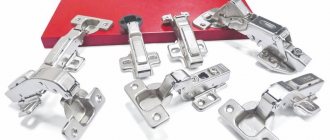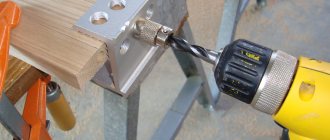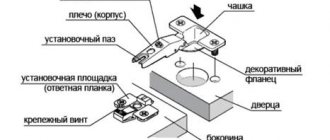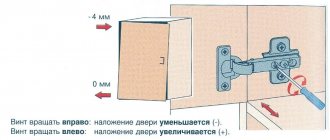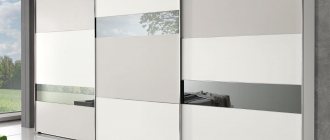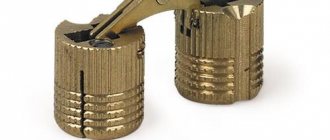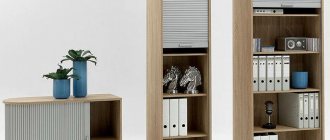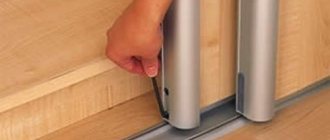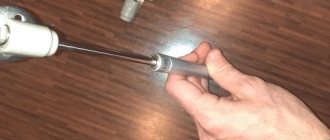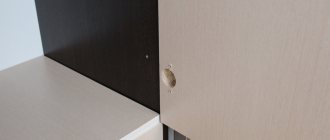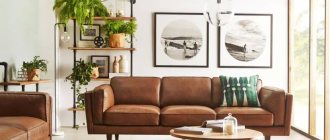In modern production, a large number of accessories are used. In this article we will look at furniture hinges for cabinets. These are mechanical devices for opening and closing swing doors. There are many different models sold in stores, and before purchasing, it is advisable to know which option will suit your facades. We will tell you about the design and installation features of canopies.
Examples of modern furniture canopies
Types of loops by design
They are hinge units that connect the doors to the cabinet body. Various design solutions make it possible to leave the door leaf open at a certain angle. Based on the method of fastening facades, you can choose the following models:
- Four-jointed.
- Mezzanine.
- Pianos.
- For glass doors.
Quadruple joint
The most common and popular are 4-hinge furniture hinges. They are distinguished by their versatility and high reliability. There are three types of four-hinged hinges, which differ from each other in the method of fastening the shoulder cup to the striker:
Slide-on. The protruding part of the strike plate fits into the shoulder. Fastening is carried out with a fixing screw. The connection has notches on both sides. The length of the arm can be lengthened or shortened by securing the connection with notches.
Clip-on. This system allows you to do without a screw. The parts of the loop are connected by a latch. Such canopies are called quick installation models. The cabinet door can be removed and replaced without tools.
Key-hole. The cup arm is placed with a hole on the counter plate screw. The edges of the opening are inserted under the screw. The mounting hole resembles a keyhole.
Their varieties are used depending on the position of the closed door relative to the wall of the cabinet body. There are the following four-hinged types:
- invoice;
- semi-invoice;
- loose-leaf;
- corner;
- inverse;
- adit.
Installation sequence
To install 180 degree hinges you do not need to have any special skills or knowledge. The product comes with instructions that describe the installation sequence and features in detail. Before work, you need to carefully consider the fastening device, evaluate its strengths and weaknesses.
Hinge installation steps:
- Preparation. You need to make sure you have the necessary tools for the job. You need to take a drill, a cutter, a level, a tape measure, and a marker.
- Marking. It is carried out in accordance with certain rules. The hinges should not be level with the shelves, there should be a distance of 50 cm between the fasteners, and 1.1-1.2 cm should be removed from the edge.
- Drilling. Holes for self-tapping screws are made in accordance with the markings.
- Screwing the hinges. The fittings are tightened using screws.
- Adjustment. Here you need to use a level and a screwdriver. It is important to place the fasteners evenly, to eliminate distortions, cracks, backlashes and other defects.
All nuances must be taken into account at the preparatory stage. When creating markings, it is important to design everything accurately so that the facades do not touch. To do this, use a special tool - a building level. The depth of the holes depends on the thickness of the doors.
An equally important adjustment step. The correctness of the process determines the functionality of the furniture. You can adjust the depth by adjusting the pressing force of the screws. Twisting oval holes helps to avoid sagging. It is possible to eliminate gaps by lateral adjustment.
Changing the installation angle
If four-hinged hinges do not allow the doors to open to the desired angle, use additional pads. You can purchase them at a furniture supermarket.
The platforms are made of plastic and metal. Place it under the hinge's mounting bar, and the angle will change in the desired direction. For example, a 10-degree overlay can either increase or decrease the installation angle of the façade.
Along with one-dimensional tabs, there are universal ones with angle adjustment. The installation platforms are equipped with a mechanism that changes the angle of inclination of the strike plate (adjustment is carried out using a screwdriver).
Adjusting the angle using a bolt
Furniture hinge fastening
Place the hinges in the drilled holes and use a ruler to adjust the position of the canopy. Make sure that the hinges are installed clearly perpendicular to the end of the door, otherwise the curvature of the door will be noticeable after installation. Then, using a pencil or an awl, mark the places for the screws in the ears of the cups. Use a screwdriver to screw the hinges to the door.
Planting cup
The most common diameter of the loop cup is 35 mm. There are models with 26 mm and 40 mm cups. You can drill out seats in the body of a door made of chipboard or MDF using a milling cutter. Pay attention to the depth of the cutter and the thickness of the facade. The mass reserve under the cup should be at least 3 - 4 mm.
The location of the holes along the height of the door is not limited in any way. Make markings for the hinges on the facade at a distance of ¼ of the length from the top and bottom of the door.
Keep the edge of the recess circle from the end of the facade at a distance of 4 - 5 mm. It's best to use a template.
Tips for choosing
A properly selected furniture hinge will ensure long-term use of the furniture. It is worth paying attention not only to the cost of products, but also to the main characteristics. Recommendations from experts will help you decide:
- The method of opening the door and the dimensions of the hinge are specified. Small facades require small canopies, and vice versa.
- Attention is paid to the manufacturer, the optimal ratio of cost and quality.
- During an external inspection of furniture corner hinges, the presence of dents, cracks and other defects is checked.
- Fittings must be certified in the Russian Federation; reliable sellers always have supporting documents.
- You should trust only specialized stores that sell original products. Qualified consultants will help you make the right choice and provide information on installation and maintenance of products.
Review of basic types of furniture fittings, selection criteria
All straight and corner furniture hinges, except cupless ones, are produced with or without closers. The action of this device can be compared to a shock absorber, which ensures smooth, silent closing of doors, without hitting the furniture body. Among the undoubted advantages of such an addition are an increase in the service life of structures, resistance to loads, and protection against leakage of oil and working fluid. The models are adjustable and serve for the tightest fit of surfaces.
For thick facades, hinges with a cup diameter of 45 mm are selected. A good option would be spring reverse models.
Specify the method of opening the door and the dimensions of the hinge
Pay attention to the manufacturer, the ratio of cost and quality
Check for dents, cracks and other defects
Selection and installation methods
Before purchasing a specific hinge model, you need to know the angle of the cabinet front to ensure convenient door opening.
To place the hinges correctly, purchase a template. Companies such as Blum offer special marking devices as an accompanying product for their products. Using the template, you can easily make markings for self-tapping screws on the front and side of the cabinet, and also accurately determine the center of the cutout using a crown for the recess for the cup.
If you learn video better than text, watch Evgeniy’s video from the BlackAsb channel, which clearly shows the rules for installing furniture hinges:
Marking
Like any other installation work, the installation of furniture hinges begins with markings. The convenience and durability of furniture depends on the correctness and accuracy of the markings.
First, make the correct calculation of the number of loops for installation. The number of hinges depends on the size and weight of the door itself (in most cases two hinges are used).
Step back 70-120 mm from the edge of the facade. An indent of 20-22 mm is made from the side edge of the door. Maintain a distance of 500-700 mm between canopies. Please note that the location of the door does not coincide with the location of the shelves.
So, measure the distance from the top, bottom and side of the door and make a mark. Using an awl, make small notches in the location of the future fastening.
Number of hinges for cabinet door
The standard number of hinges on a sash is 2 pieces. However, cabinets can be more than 2 meters high and quite wide. Based on this, you will need to determine exactly how many turning devices you need so that they can withstand the significant load from a massive door. To do this, you need to know the weight of the door leaf and refer to the table:
Loops for thick sides
When designing furniture to order, you have to adapt to the “wants” of customers, who, in turn, often turn out to be not entirely technically literate. And requests can sometimes be very strange. I had to design a cabinet with sides made of 25 mm chipboard, a so-so cabinet, medium in size, simple in configuration. But the expensive one is just terrible. The customer wanted MDF facades, such that he had to order them far away and wait more than a month. The cabinet, of course, was sawed and sent to the customer: they say, the facades will come, we’ll come and hang them. My problem is that I didn’t take into account that a simple loop, and one with a thick sidewall, won’t give a complete overlap, as the customer wants! The facades have arrived, how to plant them? Dripping with cold sweat, I began looking for an answer on forums and blogs.
Option one is to use loops with a cup with a diameter of 45 mm for the thick sidewall. Everything seems simple, the additive is clear, the loop itself has been worked out since time immemorial. But the problem is that it is catastrophically difficult to find in stock. Well, not a running size! Everyone is used to 35 mm and they don’t need another. Waiting another month for it to be delivered to order is also not an option. Among other things, also look for a cutter for them, something to attach the sidewalls with?
Option two loomed on the horizon after communicating with the Hettich manager. Who sold us a set of excellent hinges, swearing that everything would fit as it should. The hinges were brought to the workshop and installed on an improvised mock-up made of a thick sidewall and facade, but no matter how hard we worked, we were unable to achieve an overlap of more than 20mm! It is unknown where to get another 5mm - thanks, kind manager. The complete set in the photo below is still lying around in the workshop.
Option three is purely hardcore - we hang a regular loop, but in reverse: we place the cup on the side, and the counter on the front. With some effort in choosing filler sizes it works, but who would agree to this, especially since the customer already has the cabinet?
Option four is the saving one. The Blum Clip top 155 degree loop is found everywhere in any self-respecting store that sells accessories. Other manufacturers also have similar hinges, but the problem is that no one positions them as hinges for wide sidewalls. Yes, the range of problems solved by this hinge is much wider and it comes as a special-purpose hinge, but that’s why the managers selling it don’t know all its capabilities and to the question: “are there any hinges for thick sidewalls?” - They shrug their shoulders in bewilderment?
Well, okay, we found what we wanted! They began to recognize it by the additive. Well, here it is: don’t take managers at their word! Yes, they have a program compiled by blum engineers that easily calculates all this, but in the hands of the seller it is a terrible evil! They advised us to make the additive as much as 40 mm, the loop has a strange shape - why not? Does not work! Those. It also works with the adjustment turned all the way down, and it’s quite small for this loop, the overlap is 23mm! No matter how ice.
In general, the necessary additive was found by trial and error. And everything turned out to be much simpler! A regular loop with a 35mm cup is seated at 22mm, while the overlay is standard - 14mm plus or minus adjustment. We need an overlap of 25mm: 25-14-2=9mm. We add the resulting 9 mm to 22 mm of our standard additive and we get 31 mm with an adjustment of the order of plus or minus 4 mm.

